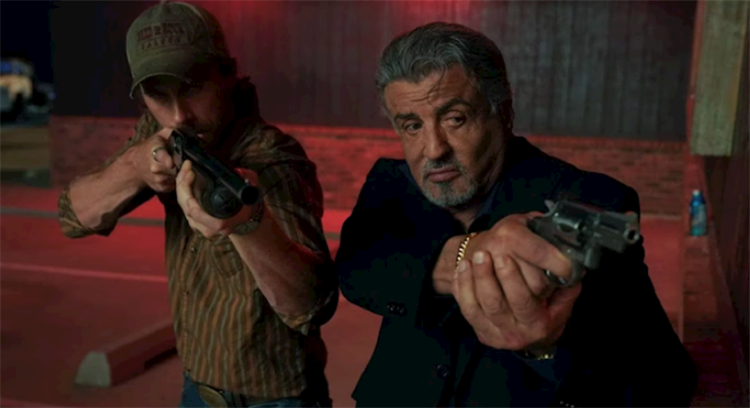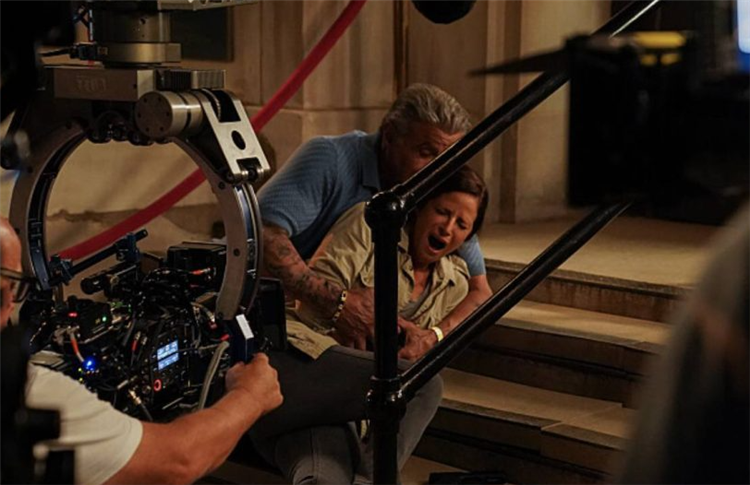Stunt coordinator Freddie Poole has worked long enough with Sylvester Stallone that, although he may not be able to finish the actor’s sentences, he can sure finish his punches. So when the call came to oversee the action on the Paramount+ series Tulsa King, Poole didn’t hesitate.
Stallone stars as Dwight “The General” Manfredi, an NYC mob capo who, after serving a 25-year prison sentence, is exiled to Tulsa, Oklahoma by his new crime bosses. Created by Taylor Sheridan (Yellowstone) and run by Terence Winter (The Sopranos), Poole knew there’d be plenty of action. Via Zoom, Poole talks about creating the Tulsa King stunts and doubling for Stallone. He also offers a preview of The Bikeriders, his upcoming feature starring Austin Butler and Tom Hardy.
How much of the Tulsa King action was on the page?
The majority — what’s on the page is the framework and then, of course, you add your touch. I would sit with Sly, share ideas, and talk things through. Nowadays, we do previz [pre-visulization]. The action team brings what’s on the page to life and presents it to the director and producers. Sometimes a show takes it almost shot by shot, or, they’ll tweak it depending on things the director may want to add.
Tell us about your favorite action sequences.
Episode three — the car chase — was a lot of fun. I directed our second unit. We had some roadblocks — no pun intended. Lightning delays shut us down for three hours. Fortunately, we got the majority of what we needed. A lot of that was due to planning ahead. A major component of our success relies on the prep. I didn’t double Stallone here. It was too much pressure to be the second unit director, stunt coordinator, and stunt double. I felt it was better for me to stay behind the camera so I could manage it all.
So you let Sylvester do the driving?

He did a couple of things. For the big pieces, I brought in Corey Eubanks. He was actually Sly’s stunt driver for Cobra and Get Carter. We got lucky. When I called, he was available. Episode four — “The Big Brawl” at the Ogallala-Land Festival — was a lot of prep, a lot of moving pieces. So many people were involved — the cast, their stunt doubles, and the biker gang. We had around 20 guys. The biker gang is made up of all stunt guys. Our director handpicked them all. I was bringing him photo after photo. I doubled and coordinated at the same time. Dwight hands the bats out and then there’s a shot with a couple of guys loading tanks in a van. He takes a swing at one of them and everything breaks loose — both sides come together almost like a battlefield. We had a nice, cool tracking shot of that happening.
Can you talk about the scene after Dwight learns his daughter was abused by Nico (John Cenatiempo)?
It was intense, very intense. We discussed how that would enrage any father. We took that emotion into the scene and went through the beats with the director and our showrunner. The scene itself was just so brutal — throwing Nico’s face on the burner and his head through the glass. Sly put his stamp on it. The foot stomp at the end and then the line, “You clean it up.” That was all him. He was throwing ideas out all season… which I love. The trip-wire gag in the finale is Sylvester’s. His character, “The General,” is nicknamed after Dwight Eisenhower. One of our conversations was, “He’s the general. He’s looking after his team. He’s got to outsmart the opposition.” And that was our approach. How do we give Dwight’s crew the upper hand?
You also doubled Stallone in the fight sequences.
I usually double him stateside. I doubled him on Samaritan. I know what he likes. It’s easy to see he likes a brawl. I know what he doesn’t like. He’ll say, “Hey look, I’m not a karate guy.” If you ever see Sylvester Stallone doing martial arts — that’s going to be a first. We always take that into account. It’s always going to be that big punch.
Explain transforming Freddie Poole into Sylvester Stallone.
It takes two and a half hours to apply the prosthetics — six pieces. During prep, production flew me out to Los Angeles and I spent the day doing a head cast. Our hair is very similar, so they styled and colored it and then applied a small hairpiece in the front. I would say I probably doubled him in seven episodes. But you’re talking about multiple times within an episode. I could be going through that process two, three days in a row. We used prosthetics because it doesn’t impede anything. I have full vision. We used a pullover mask on Samaritan. It really affected what you could see peripherally. It was a big challenge if dust or dirt got into those little eye holes. With the mask, you’ve only got one expression. You have some facial movement with the prosthetic. Taking a mask on and off is much easier, but from a performance standpoint, I’d rather be in the prosthetic.
Have you developed a Sylvester Stallone imitation?

People go, “Oh, wow, you move like him.” It’s one of those things I’ve really worked on. The walk and the way he carries himself are things I really pay attention to because it makes the process seamless. Sometimes someone would come up from behind or be next to me and start talking and not realize I’m not Sly. “You’re talking to the wrong person.”
What’s Sly’s reaction?
When you get to know Sylvester Stallone, he’s very funny. He’s like, “Do I really look like that?” He’s taking pictures when I’m half ready. I’m not in the full-on prosthetic and he’s snapping a photo with him in the frame.
Is there more Tulsa King action in your future?
It looks like season two will start filming sometime in the spring. I had an opportunity in our last episode to throw out some ideas. We didn’t have time to shoot the original concept. Once I get to read the season two scripts, we’ll all come to the table and figure out something even better.
Finally, you’ve got The Bikeriders coming out, a big film with a lot of stars. Were there a lot of stunt challenges in it?
It’s a period piece based on a book called The Bikeriders. It’s about The Outlaws, one of the first biker clubs in the Midwest. It starts in the late 50s when they were basically a riding club — a bunch of greasers tinkering with their bikes and hanging out. Then they become more gang-like. We had all those period bikes — kick starts, panhead, flathead — a lot of big pack rides that we had to figure out. The number of motorcycles was a first for me. I’ve done plenty of motorcycle work. We have motorcycles all over Tulsa King. Here, it was overseeing 40 riders. It was a lot of planning because safety is such a huge thing. We got to do a lot of fun shots. We had dirt bikes on tracks and things of that nature. We did a chase with Austin Butler. That was a single motorcycle with cop cars.
